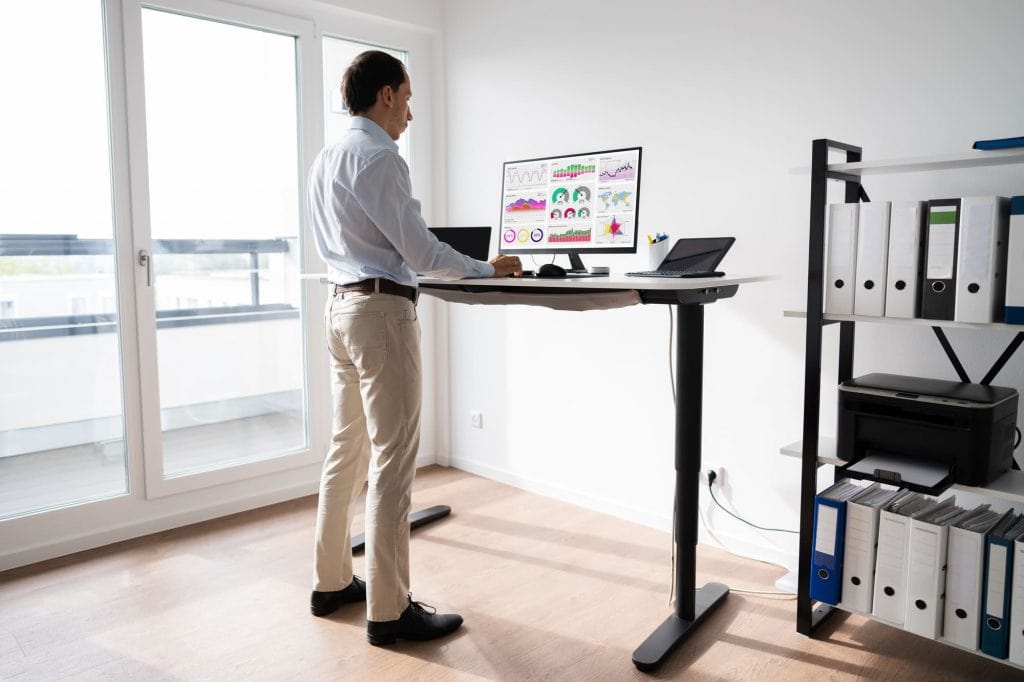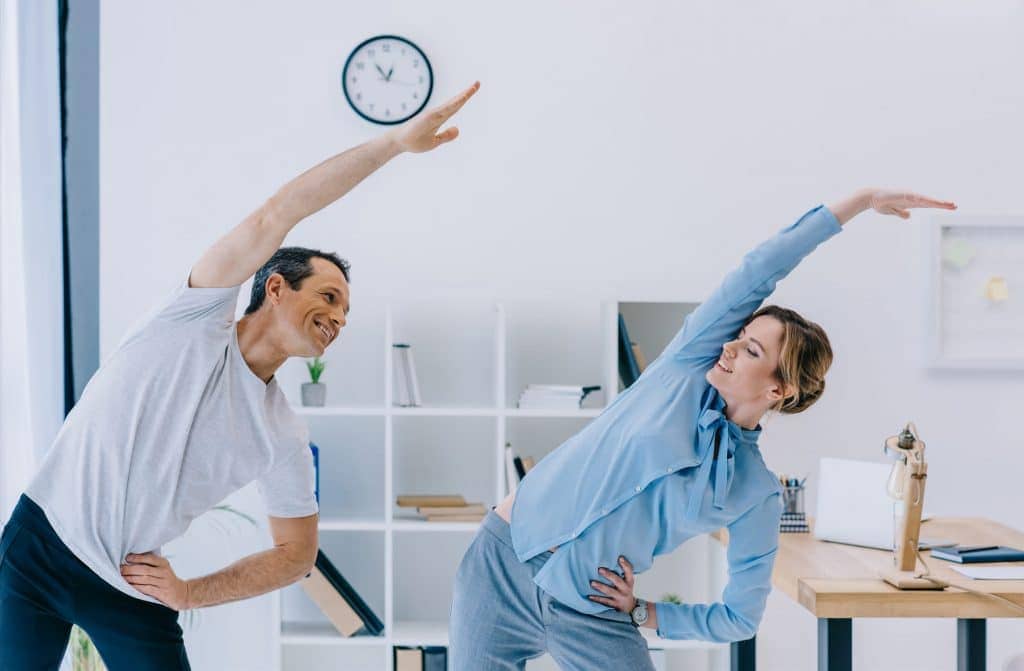*When you buy through links on our site, we may earn an affiliate commission at no additional cost to you.
The recent trend for standing desks brings a lot of new questions with it. While it’s evident that standing has some health benefits and seems to be better than sitting, a lot of other claims aren’t researched that well yet.
One commonly asked question is: “Does standing at your desk burn calories?”
The short answer is yes, of course, standing does burn calories… But everything we do burns calories.

Our metabolism is permanently active, no matter if we’re standing, sitting, or even sleeping.
The real questions that I want to answer are:
- How many calories does standing burn?
- Does it make a difference to standing?
- Is it worth it?
- Is standing healthier than sitting?
So let’s dive in.
Table of Contents
Ways To Stand While You Work

Custom-made standing desks can cost between a couple of hundreds, up to thousands of dollars. Depending on your budget you can choose from a variety of options.
You can just pick a standing desk from our list, or you can get creative.
Or you can get your workspace on the window sill, or stack a couple of books to elevate your monitor, mouse, and keyboard.
Anything that works for you is fine, but it’s kind of annoying to use something static that you can’t change easily.
If you just elevate your gear by using a box or the like, you probably won’t stand as often because you’ll have to pick up all your work stuff to elevate it, and after a while reverse that to sit down again.
A simple way of doing that would be a standing desk converter that you can just place on your regular table.
My personal recommendation is to get a standing desk frame and pick a tabletop you like. The easiest and most budget-friendly way would be a tabletop from IKEA or your local carpenter or hardware store.
Thus you can get creative and get your favorite design while saving some money.
How Many Calories Does Standing At Your Desk Burn?
Standing burns around 88 calories per hour on average, adding around 6% more for actively working instead of passively watching TV or the like. The difference in calorie burn between sitting and standing is probably minor in between 8-13 calories more per hour while standing.
Research Nr.1

Standing at your desk burns significantly fewer calories than you might think if compared to sitting.
Let’s take a look at two studies. One of them was published a couple of years ago in the Journal of Physical Activity and Health.[1]
This study measured energy expenditure in 74 participants using indirect calorimetry, a very reliant method by measuring respiratory gases, in 15-minute intervals of sitting and standing, or walking.
It shows that people on average burn around:
- 75 calories per hour while sitting watching TV
- 80 calories per hour while sitting at a computer working
- 88 calories per hour standing watching TV
- 224 calories per hour while walking
- 300 (minimum) per hour while running
These results also vary from additional factors like sex, age, weight etc. you can use a calorie burn calculator to determine a more accurate number, but let’s use these average numbers from the study as an example.
As you can see the calories burned aren’t that much. Standing only burns 8 calories more than sitting at a PC. Theoretically, that would mean in an 8-hour workday you’ll only burn 64 kcal more IF you stand all day.
Unfortunately, this study doesn’t show how many calories are burned by people standing, while working on a PC. As you can see there is also a difference in calories burned between sitting while watching TV and while working.
That leads to the assumption that the calorie burn in standing while working would be also slightly higher (around 6%), resulting in an extra 5 calories burned per hour, increasing the total amount for a workday to 104 calories burned.
Furthermore, there is an additional energy expenditure when changing positions.
But let’s be honest here. You won’t stand for 8 hours at your computer desk…and you shouldn’t.
Even when we assume you would burn those extra calories of around 100 kcal per day on average you would still need about 1-2 months to burn one pound of body fat.
Research Nr.2

Another paper was published on “Occupational Medicine”[2]. Researchers wanted to answer if there is a meaningful increase in energy expenditure while using sit-stand desks in recommended 4h/day of standing.
This study shows an expenditure of 57 kcal in men and 48 kcal in women on average. Men usually burn more calories because they naturally have a higher muscle mass than women. Muscles use up a lot of energy and add up significantly to the amount of calories burned.
Expanding these results to the 8-hour workday of the previous research we get quite similar numbers.
Are Standing Desks Worth It In Terms Of Calorie Burn?
Standing desks are not necessarily worth it in terms of calories burned. But they have a lot of other health benefits, which we’ll discuss in a minute.
The studies show that standing doesn’t burn that many calories. If we add up the energy you need for standing up and sitting down again, we can assume an extra burned calories of around 50-100 calories for a whole workday on average.
So if you think you can lose weight by standing up from time to time, I have to disappoint you.
In terms of extra calories burned, it’s not really worth it to get a standing desk. If you scroll up to the first research paper, you’ll see that walking burns significantly more calories than sitting or standing.
So just taking a short break of a couple of minutes from time to time walking around will do much more of a difference in terms of calories burned.
Walking for one hour burns around 224 calories, which is roughly the caloric equivalent of burning a snickers bar, while standing only burns around 88 kcal.
So if your intention is to lose weight, it would be more beneficial to increase the number of steps you walk every day. According to the compendium of physical activities walking burns 3 times as many calories as sitting and watching TV.[3]
Furthermore, you should build some muscle mass, as energy and fat are burned right in the muscle. Thus you increase your basic metabolic rate which will increase the number of calories burned on autopilot.
But burning calories was never the intention for using standing desks. There are way more benefits than that.
Health Benefits Of Using A Standing Desk
The original idea of a standing desk was not to burn more calories but to prevent risk-factors and diseases caused by sedentary office work.
Numerous studies show a lot of negative impacts on your health when you sit a lot, staring at your computer screen for the whole day.
Even the American Heart Association warns about the dangers of sedentary work. [4]
Common side effects are:
- high blood pressure
- higher blood sugar
- back pain/neck pain
- obesity
- depression
- increased insulin resistance
- increased risk of type 2 diabetes
- deep vein thrombosis
- heart disease
- cancer
- increased risk for death and higher mortality rates
The more often you change your position from sitting to standing and walking the better for your overall health and well-being.
If you want to get some more tips on that check out our article about how often you should stand up.
By using a standing desk you can enjoy these health benefits:
- lower the risk of obesity and weight gain
- improved blood sugar control
- decrease the risk of heart disease
- reduce back pain
- improve your energy levels and mood
- enhance productivity
- reduce caffeine dependency
So even if the calorie burn doesn’t increase that much comparing to sitting, a stand up desk will help you with a lot of other benefits.
Why Standing For Too Long Is Also Bad
As usual “too much” of something always comes with negative side effects. As much as we know that too much sitting is bad for your health, people who stand all day at work also know this can’t be the solution.
There is a publication in the “Ergonomics” magazine with the title “A detailed description of the short-term musculoskeletal and cognitive effects of prolonged standing for office computer work“.[5]
So what happens to your body and focus when standing for too long?
The study shows a number of negative effects after constantly standing for 2 hours like:
- Increased discomfort in all body areas
- Sustained reaction time deteriorated
- Increased lower limb/legs swelling
- Mental state decreased
But the creative problem solving improved.
Standing is way more exhausting than sitting. It can happen that you lose your focus and start feeling some pressure in your heels.
It takes some time to get used to the new work position.
From my own experience, I can confirm that it’s quite uncomfortable and unfamiliar to stand while working on a PC.
But after a while, my back pain improved, and especially on Zoom meetings, I prefer standing and tip-toeing around rather than sitting.
So I would love to see some research with more participants, over a longer period of time, when they get used to standing while working. I would assume there would be more benefits.
Also read: How A Standing Desk Works
The Perfect Ergonomics and Recommendations
Office ergonomics came a long way. There’s constant development in office furniture including desks, chairs, treadmills, and other gadgets.
Here is the perfect state-of-the-art setup and recommendations for your day at the office or PC.
- First of all, adjust your chair and workspace the right way. Use all the possibilities you have to create the perfect position while sitting.
- Get a standing desk or a place you can elevate your workspace, even putting your laptop on the window sill would be good. Just make sure you have the possibility to stand up while working.
- Constantly standing is nearly as bad as sitting move. Change positions appropriately often to move around as much as possible.
- Get a balance mat for the standing periods to avoid pressure through weight on your heels on a hard surface and train your muscles while standing.

- Take some breaks and walk a couple of steps, stretch your muscles a little and make sure to get some physical activity on a daily basis. The key is to move as much as possible during the day.
- The next level is a treadmill desk or cycling desk, so you can be active even while you work.
- When you’re doing remote or creative tasks, like making a phone call, stand up.
- When you’re doing work that requires a lot of concentration sit down.
- Get some balance by working out 2-3 times per week.
By following these guidelines you can burn some extra calories habitually and also prevent weight gain and risk factors for numerous diseases.
Also read: Why are standing desks so popular?
Conclusion and Perspective
No matter what we do, we’re constantly burning calories, even while watching TV. The amount of calories burned changes with our energy level.
Standing does burn slightly more calories than sitting, but it’s not enough for significant weight loss if that’s what you’re intending.
Even though the increased calorie burn isn’t significant it’s reasonable to get a standing desk or elevated workspace for a number of positive effects on the body and mind.

The key for a healthy body in sedentary work is a constant change of your position from sitting to standing, even changing your seating from time to time, while considering your chair and desk ergonomics.
Also, bring more activity in your life by taking a couple of active breaks and working out habitually.
Regarding all those guidelines, it’s very unlikely that you’ll have any issues despite being a sedentary worker.
Get more free health information and the studies mentioned in my articles from the original sources.
[1]https://pubmed.ncbi.nlm.nih.gov/26693809/
[2]https://pubmed.ncbi.nlm.nih.gov/27515973/
[3]https://download.lww.com/wolterskluwer_vitalstream_com/PermaLink/MSS/A/MSS_43_8_2011_06_13_AINSWORTH_202093_SDC1.pdf
[4]https://www.heart.org/en/news/2018/05/01/sitting-too-much-may-raise-heart-disease-risk
[5]https://www.tandfonline.com/doi/abs/10.1080/00140139.2017.1420825?scroll=top&needAccess=true&journalCode=terg20&



